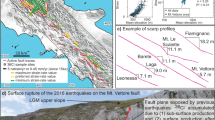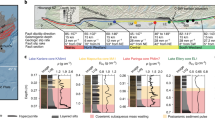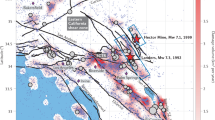Abstract
Earthquake-producing fault systems like the San Andreas fault in California show self-similar structural variation1; earthquakes cluster in space, leaving aseismic gaps between clusters. Whether gaps represent overdue earthquakes or signify diminished risk is a question with which seismic-hazard forecasters wrestle1,2,3,4,5. Here I use spectral analysis of the spatial distribution of seismicity along the San Andreas fault (for earthquakes that are at least 2 in magnitude), which reveals that it obeys a power-law relationship, indicative of self-similarity in clusters across a range of spatial scales. To determine whether the observed clustering of earthquakes is the result of a heterogeneous stress distribution, I use a finite-element method to simulate the motion of two rigid blocks past each other along a model fault surface that shows three-dimensional complexity on the basis of mapped traces of the San Andreas fault. The results indicate that long-term slip on the model fault generates a temporally stable, spatially variable distribution of stress that shows the same power-law relationship as the earthquake distribution. At the highest rates of San Andreas fault slip (40 mm yr−1), stress patterns produced are stable over a minimum of 25,000 years before the model fault system evolves into a new configuration. These results suggest that although gaps are not immune to rupture propagation they are less likely to be nucleation sites for earthquakes.
This is a preview of subscription content, access via your institution
Access options
Subscribe to this journal
Receive 12 print issues and online access
$259.00 per year
only $21.58 per issue
Buy this article
- Purchase on Springer Link
- Instant access to full article PDF
Prices may be subject to local taxes which are calculated during checkout




Similar content being viewed by others
References
Kagan, Y. Y. & Knopoff, L. Spatial distribution of earthquakes: The two-point correlation function. Geophys. J. R. Astron. Soc. 62, 303–320 (1980).
McCann, W. R., Nishenko, S. P., Sykes, L. R. & Krause, J. Seismic gaps and plate tectonics: Seismic potential for major boundaries. Pure Appl. Geophys. 117, 1082–1147 (1979).
Nishenko, S. P. Circum-Pacific seismic potential—1989–1999. Pure Appl. Geophys. 135, 169–259 (1991).
Kagan, Y. Y. & Jackson, D. D. Seismic gap hypothesis: Ten years after. J. Geophys. Res. 96, 21419–21429 (1991).
Rong, Y., Jackson, D. D. & Kagan, Y. Y. Sesimic gaps and earthquakes, J. Geophys. Res. 108 (2003) (doi:10.1029/2002JB002334).
Kafka, A. L. & Ebel, J. E. Exaggerated claims about earthquake predictions. EOS 88, 1–6 (2007).
Thomson, D. J. Spectrum estimation and harmonic analysis. Proc. IEEE 70, 1055–1096 (1982).
Percival, D. B. & Walden, A. T. Spectral Analysis for Physical Applications (Cambridge Univ. Press, Cambridge, 1993).
Ghil, M. et al. Advanced spectral methods for climatic time series. Rev. Geophys. 40, 3.1–3.41 (2002).
Voss, R. F. & Clarke, J. “1/f noise” in music: Music from 1/f noise. J. Acoust. Soc. Am. 63, 258–263 (1978).
Schroeder, M. Fractals, Chaos, Power Laws (W. H. Freeman and Company, New York, 1991).
Scholz, C. H. The Mechanics of Earthquakes and Faulting (Cambridge Univ. Press, Cambridge, 2002).
Segall, P. & Pollard, D. D. Mechanics of discontinuous faults. J. Geophys. Res. 85, 4337–4350 (1980).
Aviles, C. A., Scholz, C. H. & Boatwright, J. Fractal analysis applied to characteristic segments of the San Andreas fault. J. Geophys. Res. 92, 331–344 (1987).
Okubo, P. G. & Aki, K. Fractal geometry in the San Andreas fault system. J. Geophys. Res. 92, 345–355 (1987).
Power, W. L., Tullis, T. E., Brown, S., Boitnott, G. N. & Scholz, C. H. Roughness of natural fault surfaces. Geophys. Res. Lett. 14, 29–32 (1987).
Kagan, Y. Y. Fractal dimension of brittle fracture. J. Nonlinear Sci. 1, 1–16 (1991).
Marsan, D. Can coseismic stress variability suppress seismicity shadows? Insights from a rate-and-state friction model. J. Geophys. Res. 111 (2006) (doi:10.1029/2005JB004060).
ANSYS Inc, Multiphysics Finite Element Software, Version 11 (Canonsburg, PA, 2007).
Jennings, C. W. Fault activity map of California and adjacent areas with locations and ages of recent volcanic eruptions. California Division of Mines and Geology Data Map Series No. 6, 92 p., 2 plates, map scale 1:750,000 (1994).
Brown, S. R. & Scholz, C. H. Broad bandwidth study of the topography of natural rock surfaces. J. Geophys. Res. 90, 2575–2582 (1985).
Sagy, A., Brodsky, E. E. & Axen, G. J. Evolution of fault-surface roughness with slip. Geology 35, 283–286 (2007).
Brune, J. N., Henyey, T. & Roy, R. F. Heat flow, stress, and the rate of slip along the San Andreas fault, California. J. Geophys. Res. 74, 3821–3827 (1969).
Zoback, M. D. et al. New evidence of the state of stress of the San Andreas fault system. Science 238, 1105–1111 (1987).
Reasenberg, P. A. & Simpson, R. W. Response of regional seismicity to the static stress change produced by the Loma Prieta earthquake. Science 255, 1687–1690 (1992).
Geist, E. L. & Andrews, D. J. Slip rates on San Francisco Bay area faults from anelastic deformation of the continental lithosphere. J. Geophys. Res. 105, 25543–25552 (2000).
Christensen, N. I. Poisson’s ratio and crustal seismology. J. Geophys. Res. 101, 3139–3156 (1996).
Byerlee, J. D. Friction of rocks. Pure Appl. Geophys. 116, 615–626 (1978).
Birch, F. Compressibility; elastic constants. Geol. Soc. Am. Mem. 97, 97–173 (1966).
Weldon, R., Scharer, K., Fumal, T. & Biasi, G. Wrightwood and the earthquake cycle: What the long recurrence record tells us about how faults work. GSA Today 14, 4–10 (2004).
Acknowledgements
This work was inspired by a presentation on irregular faults by Jim Dieterich, research by David Marsan and a conversation with Larry Hartge.
Author information
Authors and Affiliations
Corresponding author
Supplementary information
Supplementary Information
Supplementary figure 1 (PDF 83 kb)
Rights and permissions
About this article
Cite this article
Parsons, T. Persistent earthquake clusters and gaps from slip on irregular faults. Nature Geosci 1, 59–63 (2008). https://doi.org/10.1038/ngeo.2007.36
Received:
Accepted:
Published:
Issue Date:
DOI: https://doi.org/10.1038/ngeo.2007.36
This article is cited by
-
The influence of earthquake source complexity on frequency-dependent radiation patterns by modifying distance-dependent properties
Journal of Seismology (2024)
-
Spatial and temporal microseismic evolution before rock burst in steeply dipping thick coal seams under alternating mining of adjacent coal seams
Arabian Journal of Geosciences (2021)
-
Precursor of Spatio-temporal Evolution Law of MS and AE Activities for Rock Burst Warning in Steeply Inclined and Extremely Thick Coal Seams Under Caving Mining Conditions
Rock Mechanics and Rock Engineering (2019)



